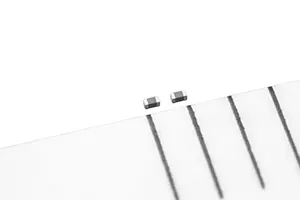source: TDK news
TDK Corporation announced the expansion of its lineup of chip varistors for automotive applications. The AVRH series offers a maximum operating voltage of 19 V to 70 V and a capacitance ranging from 4.7 to 50 pF. The miniature voltage protection device is available in IEC case 1005 (EIA 0402) with compact dimensions of just 1.0 mm x 0.5 mm x 0.5 mm, which makes the new component 75 percent smaller than existing components with comparable performance. The high reliability AVRH series, which also features a wide operating temperature range of -55 to 150 °C, can withstand contact discharges of 25 kV to IEC 61000-4-2 and are qualified to AEC-Q200.
The new AVRH series uses TDK’s unique coating technology to achieve the high reliability required in automobiles. The AVRH series is thus suitable for use in various automotive ECUs and bus systems such as LIN, CAN, CAN-FD, and FlexRay. Moreover, the chip varistors can be used in systems that use BroadR-Reach, MOST or automotive Ethernet.
In recent years, as cars have become equipped with many additional functions such as advanced driver assistance systems (ADAS) and in-vehicle infotainment (IVI) networks, the downsizing of the ECUs and increased reliability have become even more important. As a result, ESD and surge protection devices also need to be smaller and offer higher reliability. TDK will further increase the product lineup in terms of compactness, operating voltage and capacitance to support a wide range of automotive device designs.
Main applications
- Various automotive ECUs
- Automotive bus systems such as LIN, CAN, CAN-FD, and FlexRay
- Advanced driver assistance systems (ADAS) and in-vehicle infotainment (IVI) applications that use BroadR-Reach, MOST or automotive Ethernet
Main features and benefits
- Miniature dimensions of 1.0 mm x 0.5 mm x 0.5 mm
- 75% smaller than existing components with comparable performance
- High operating temperatures up to 150 °C
- Qualified to AEC-Q200
Key data
| Type | Dimensions [mm] |
Max. operating voltage [V DC] |
Capacitance [pF] |
|---|---|---|---|
| AVRH10C101KT4R7FA8 | 1.0 x 0.5 x 0.5 | 70 | 4.7 * |
| AVRH10C270KT150NA8 | 19 | 15 ** | |
| AVRH10C390KT500NA8 | 28 | 50 ** |
* At 1 MHz
** At 1 kHz































